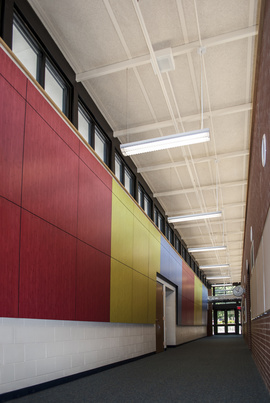Posted on May 27, 2016
Choosing the colors and materials for any building or remodeling project can be a daunting task. The choices are virtually endless, and it can be tempting to let your gut be your guide. But your gut probably doesn’t know the profound impact the details of a space can have on the people using it.
Color—and the materials, lighting, and other colors that influence the way we perceive it—can affect your mood, productivity level, perceived temperature, and even, some say, your appetite.
Magazines, Pinterest, and personal blogs are full of advice and easy answers on how to choose the right colors and materials for your interior spaces. The problem is that the easy answer isn’t always the right answer for you.
Ekaterina Barybina, an architect at BG who specializes in interior design, explains that you can’t always trust the trends you see in the media. “Something that is modern or cool is not necessarily going to make you happy,” she says. “Each space is designed for a particular function, and something that you see in a magazine may not work for your personal space.”
When designing interior spaces, there is a myriad of factors to consider, including the function of the space, how much time people will spend in it, and the mood you want the space to evoke.
Transitory spaces like hallways or entryways, for example, might enliven a space with brighter, bolder colors, but the same design features in a space where people will spend long periods of time could lead to unhappiness, uneasiness, or a lack of productivity.
A bank might use natural wood and stone with a neutral palette and rich accent colors to convey a sense of wealth, sophistication, honesty, and friendliness.
A staff lounge in a hospital could use green tones, comfortable furniture, and natural light (or, at least, the illusion of natural light) to create a quiet refuge away from the stimulating and stressful hospital environment.
An office space intended to enhance productivity, might have one area designed with neutral or subdued colors for long periods of thoughtful or analytical work, and another accented with brighter, more stimulating colors where employees can reenergize.
Design in Action: Elementary School Spaces
Some of Barybina’s favorite places to design are schools. “I am very passionate about educational architecture,” she says. “Every time I try new ways to make kids happy and learn better, that makes me happy.”
For a long time, most classrooms were painted a single color. After taking a seminar on color’s impact on students, however, Barybina began adding an accent wall on most of the classrooms she designed. The more dynamic color scheme offers more stimulation for students, and teachers noticed that their students had more energy and attentiveness throughout the day.
“I was one of the first people in Lawrence to start using accent walls in learning environments,” Barybina says. “I take pride in that.”
In elementary schools, Barybina tends to keep designs stimulating and fun. She likes to fill hallways and other commons areas with bright splashes of color. In the classroom, she goes for more subdued colors to avoid overstimulation. Plus, teachers often bring in a lot of bright and colorful educational materials of their own, which could clash with a bold color palette.
In any design project, Barybina explains, it is essential to consider what clients will add to the space and design.
Acoustics are another major concern in the classroom. Sound tends to bounce off of hard surfaces. In a classroom, that could lead to a more disruptive environment.
If you have a classroom with hard walls, ceiling, and flooring, Barybina states, “Kids are going to be really frustrated in that space.”
Your Vision Matters
The most important factor that goes into designing interiors, however, is what you want.
“I always ask clients to show me what they like, or I will give them homework to start thinking about what they want,” Barybina says. “I’m never opposed to them bringing me ideas that they saw somewhere else. I want them to put what they want on the table.”
The challenge — and the fun — of interior design is applying our professional knowledge and experience to make each individual client happy.
To learn more about interior design and architecture, check out some of the projects BG has completed over the years.




